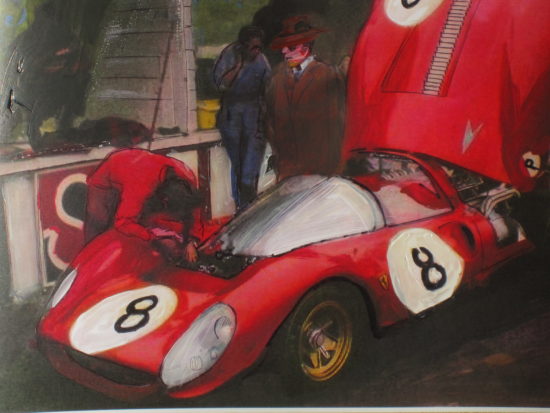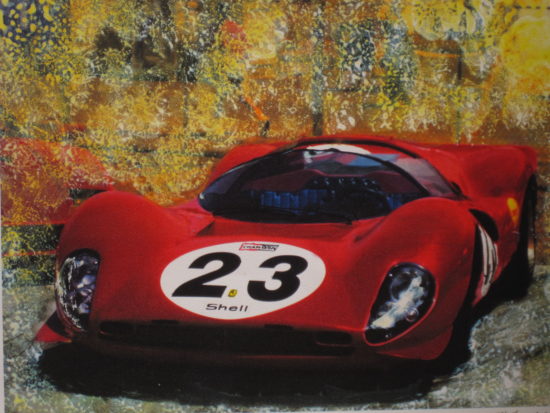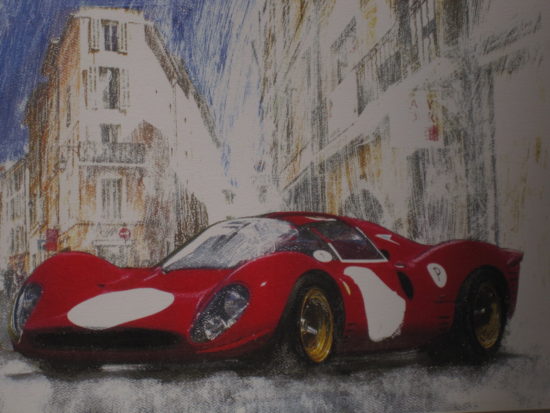by Wallace Wyss –
One of the great mysteries of endurance racing in the Sixties is why Enzo Ferrari, arguably the superior technician in developing race cars, couldn’t beat Ford at Le Mans in ’66 with the Ferrari 330 P3.
It wasn’t for lack of trying. Ferrari had won Le Mans five times in a row, leading up to the 1966 battle. So they had the experience over Ford. Their cars were lighter.
They had more cylinders. You might say “What difference does that make?” but I myself owned a 12 cylinder Ferrari and drove around with only ten working. The less cylinders you have, the less chance you can continue if one or two goes out.
The great thing about the years ’64 through ’66 at Le Mans is that they resulted in what I consider the ultimate racing Ferrari of the ‘60s, the P3, which became the P3/4 then P4.
As the movie Ford v. Ferrari (premiering Nov. 15th) will show, the battle was joined as a sort of offspring of a spurned love affair. Henry Ford II wanted Ford to expand in Europe. But Ford, due to the Model T Ford generations earlier, had a sort of El Cheapo “cars for the masses” image. After Henry Ford II married an Italian and they went to a Le Mans race where Ferrari won, she supposedly made a catty remark like “Ford could never make a car the equal of the Ferrari.” So ol’ Henry finds out Enzo is short of working capital and makes an offer.
A deal was almost struck in 1963, but Enzo got really energized when he discovered they would control his racing expenditures and even call some of his cars Ford-Ferraris. He and his minions walked out of the meeting…
So Henry gave the order to develop a race car that could take on Ferrari. Not easy. Ferrari had all the endurance racing experience, Ford only had backed Shelby’s Cobras as experience but those cars were, to be blunt, old stuff, the Cobra being based on the 1953 A.C. Ace, a totally obsolete car and aerodynamically not fit to top 165 mph. It was getting obvious you had to top 200 mph to win Le Mans.
Ferrari had a good car in the mid-engined 250LM but even that wasn’t aerodynamic enough for the biggest battle with Ford, in’66. They had actually won the ’65 race with a leftover used 250LM they had sold an American dealer, so it was a fluke. The Ford GTs raced in the race weren’t sorted out yet.
For ’66 Ferrari’s pride of place was the 330 P3,
Ferrari 330 P3 SPECS
Engine: 4.0-liter V12
Transmission 5-Speed Manual
Top Speed: 193 MPH
0-60: N/A
Horsepower: 420 @ 8,200 rpm
Weight: 1,587 lbs
No. Produced: 3
Chassis: Monocoque
It actually was a more efficient car than the earlier P2. Some fiberglass was used instead of alloy. The tried and true Weber carbs were tossed out for Lucas fuel injection. The cars were supposed to be two seaters but the driver’s seat was more centered.
The P3 enjoyed a wider track for better handling. It was lighter by 200 lbs. than its predecessor.
The engine was rated at 410 horsepower and ironically it was using a German made 5-speed ZF gearbox (previously Ferrari built gearboxes in house for P-Series cars) the same brand as Ford was using. They had tested the car up to 193 miles per hour.
But weren’t the Ford GTs with 7 liters capable of doing over 200 mph? Yes indeedy. But they couldn’t run at full redline all day long where the Ferraris could.
So ultimately the victory came to how many cars you could field on the grid. Ford had over ten Ford GTs on the grid in ’66 where Ferrari had less than one third that. So every Ferrari prototype would have to contend with three Ford GTs!

I don’t know if in the movie they will show Enzo Ferrari at Le Mans. But I envisioned him there, in the pits with a prototype – art by Wallace Wyss
My question for a Ferrari historian is: why didn’t Ferrari suspend F1 racing for one season so he could dump all his racing budget into making more Le Mans prototypes? The answer will probably be that he was over confident, in that he had beat Ford in ’65. But that wasn’t really a win he could credit himself with as the Ferrari winner in ’65 was a private team driving a used car.
So Ford took 1-2-3 at Le Mans in ’66 and the P3 was almost shoved into the dustbin of history. Except that now it is being recognized as one of Ferrari’s most beautiful cars.
Ferrari didn’t lose face entirely, as a P3 took first in the 1966 Spa 1000km in Belgium.
Ferrari 330 P4 (P3/4) SPECS
Engine 4.0-liter V12
Transmission: 5-Speed Manual
Horsepower: 450 @ 8,000 rpm
0-60: 5 sec
Top Speed: 210 mph
Weight: 1,746 pounds
No. Produced: 4 (3 P4s, 1 P3/4)
Chassis: Monocoque
In 1967 the P3 evolved into the 330 P4. Though it looked almost the same if you lifted the rear bonnet, you saw a V12 from F1, one that had been enlarged to 4 liters and had three valves per cylinder and a new rating of 450 hp.
But again it failed to vanquish Ford at Le Mans. Ferrari did have one last laugh, though, at the Daytona 24 hours when a Ferrari P4, a 412P and the P3/4 crossed the finish line at the 24 Hours of Daytona together, rubbing it in that Ferrari wasn’t quite dead yet….
Let us know what you think in the Comments.
THE AUTHOR/ARTIST: Wallace Wyss has painted portraits of P3, P3/4 and P4 Ferrari prototypes (and even the 412, a version sold to other race teams). These can be commissioned as 20” x 30” giclees on canvas. Write mendoart7@gmail.com







Not only did the 330 P3/4 also win the 1967 Le Mans Test Trials, and a 330 P4 the 1967 Monza 1000 KM, but also the 1967 Championship, beating Ford and Porsche.
I am hoping someone will tell me why Enzo did not think winning LeMans was more important than staying in F1 in ’66. On the other hand, the firm he founded is still selling exotic cars more than half a century later, which; is coasting a long time on his marque’s earlier LeMans wins.